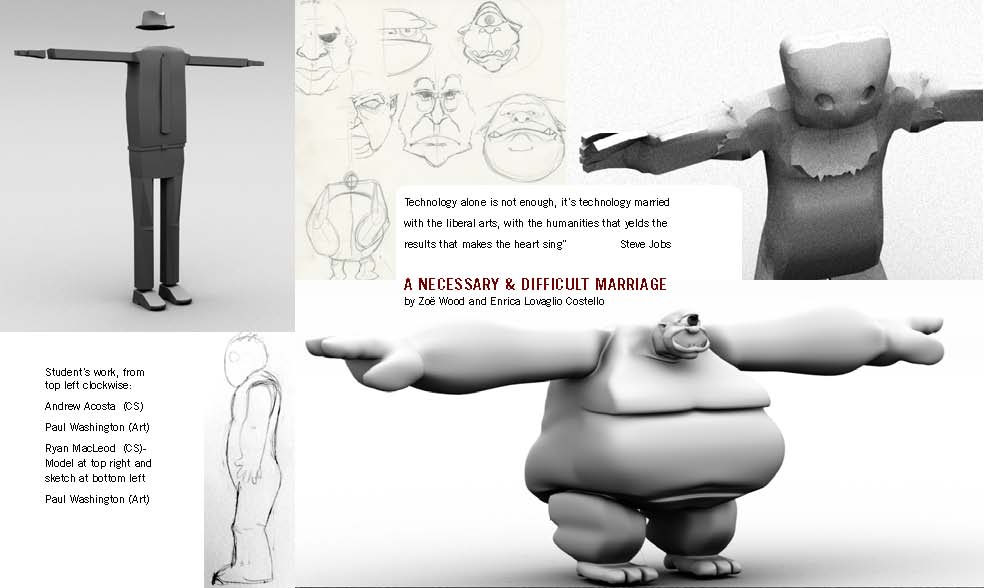
Computing for the Interactive Arts is a new cross-disciplinary minor between Art and Computer Science. The curriculm focuses on collaborative, cross-disciplinary environment in which Art and Design students integrate coding and algorithmic thinking in creative works and Computer Science students apply the principles and methodology of design thinking to visual applications.
Current webpage: http://www.computingforinteractivearts.com/
The minor enables students from different disciplines to collaborate on projects requiring both a technical and a creative perspective.
The minor has been approved for the Cal Poly 2015 Course catalog.
Information about declaring the minor can be found here:
http://eadvise.calpoly.edu/minors/computing-for-interactive-arts-minor/
2019 Capstone write up poster presented at FDG 2019
Examples of the 2017 capstone projects.
Required Courses
ART r182 Course ART r182 4
ART r183 Course ART r183 4
ART 384 Digital 3D Modeling and Design (*) 4
CSC 123 Introduction to Computing
CSC/CPE 101 Fundamentals of Computer Science I 4
CSC/CPE 102 Fundamentals of Computer Science II 4
CSC/ART 350 Computing for Interactive Arts Capstone I
CSC/ART 450 Computing for Interactive Arts Capstone II
Approved Art and Design Electives
Select 8 units from the following:
ART 302 Figure Drawing
ART 334 Illustration I: Techniques and Tools
ART 383 Digital Video I
ART 434 Illustration II
ART 474 Collaborative Studio: Rendering, Animation and Modeling
Approved Computer Science Electives
Select 8 units from the following:
CSC 371 Game Design
CSC/CPE 378 Interactive Entertainment Engineering
CSC/CPE 471 Introduction to Computer Graphics
CSC/CPE 473 Advanced Rendering Techniques
CSC/CPE 474 Computer Animation
CSC/CPE 476 Real-Time 3D Computer Graphics Software
CSC/CPE 478 Current Topics in Computer Graphics
CSC/CPE 480 Artificial Intelligence
CSC/CPE 481 Knowledge Based Systems
For example, as an art student,
in addition to their normal art classes (Art 182, 183 and 3 Art and Design electives), a CIA minor would also take:
CSC/CPE 123-102 (12 units)
Two CSC electives (371 and 378 at this time) (8 units)
CIA capstone 350/450 = 4 units total
for a total in addition to art/design is 24 units
similarly for CSC students, in addition to their normal CSC major classes (CSC 101, 102, 103 and CSC electives), a CIA minor would also take:
Art 182, 183, 384 (12 units)
Two Art electives (8 units)
CIA capstone 350/450 = 4 units total
for a total in addition to art/design is 24 units
This unit counting can be seen in the following document or example flowcharts show potential paths through the course work for the various majors:
Art/Design Studio Art concentration
Art/Design Graphic Design concentration
Art/Design Photography and Video concentration
Computer Science Majors
*Note that the CS electives that Art CIA students could take with a CSC background up to CPE 102 would be:
CSC 371 Game Design and CSC 378 Interactive Entertainment Engineering
or students may optionally take up to CPE 103 - with access to the larger list of CS electives above
For more information, contact
Professor Wood
or
Keen
in the computer science department
or
Professor Costello
in Art & Design.
The program learning objectives include:
1 Produce a strong body of work and/or professional portfolio via combined principles of art/design and the methodology of design thinking with algorithmic thinking.
2 Establish and maintain a rigorous creative and technical practice that is productive and professional.
3 Employ an articulate, sophisticated visual, verbal, and technical vocabulary related to art and design from a range of styles and periods.
4 Apply comparative reasoning in evaluating works of interactive art and design.
5 Contribute to diverse, cross-disciplinary, collaborative interactive computing endeavors as a team member.
6 Resolve problems at the interface of art and design and computer science through innovative thinking and visual expression.
7 Demonstrate an ability to evaluate ethical consequences in creative expression, technical innovation and professional practice.
8 Practice life long learning, inquiry, and discovery via directed self-research and inquiry for artistic and technical projects.
Faculty involvement includes:
Zoë Wood (CSC): CPE 123, CPE 471, 473, and 476, curriculum development
Enrica Lovaglio Costello (Art&Design): ART 182, 183 and 384, curriculum development
Aaron Keen (CSC): CPE 101, 102, and curriculum Development
Michael Haungs (CSC): CSC 123 and 171 and 371
Foaad Khosmood (CPE): CSC 378 and CSC 480, Global Game Jam, CPGD
Shinjiro Sueda (CSC): CPE 471 and 474
Mary LaPorte (ART)
Charmaie Martinez (ART)